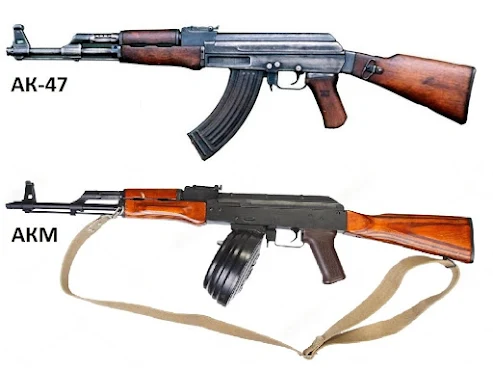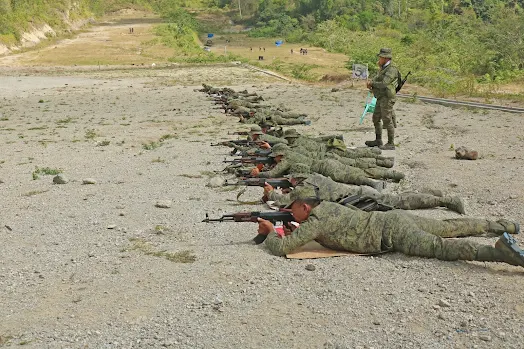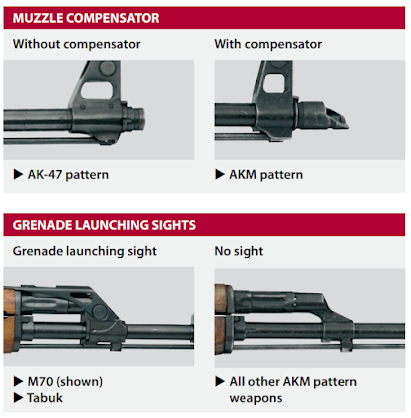DISCUSSION OVERVIEW
 |
| Here is an image of an infantry trooper belonging to the Philippine Army firing a target using an AKM Assault Rifle. Image originated from First Field Artillery Battalion, Philippine Army. |
In the traditional sense of how the Philippine Army comes into being, from in its inception in the late 1890s to fight for freedom against Spain and then fighting against the United States and eventually gets succumbed and comes into being once more under the commonwealth government of the mid-1930s, it will be not that surprising that the current armaments and weaponry of the land service branch primarily originates from the United States, if not the countries that adopt its weapons standardization.
This means that the modern infantry that defines the Philippines’ core military usually comes with different variations of firearms, specifically the ones that have originated from western sources such as the Remington R4 or M4-derived rifles, the iconic M-16 rifles or the ones refurbished by the Government Arsenal or GA, or the other firearms that bear some semblance or have similar caliber such as the SIG Sauer SIGM400 or the Heckler & Koch HK416, which are limited to several units.
While these western-based firearms are a mainstay for the Philippine Army’s western-oriented infantry, there are several oddities on some weapons load-out that the service branch have in its inventory, of which this comes as the primary topic in discussion for this article. This points to the organization’s existence of AKM rifles in its inventory, whereby it primarily is not of western origin and is likely from either the eastern bloc countries or even from the country that produces such weapons like Russia.
The existence of such rifles in the Philippine Army’s inventory comes at the benefit of the troops familiarizing and understanding its uses, while coming at the cost of logistics and interoperability as these rifles come with a different caliber.
Specifically, details like this will come as this discussion proceeds along, with the quirks on different design features and technicalities permeating its understanding and operational use to the entire service branch as western-made weaponry remains as mainstream in the organization.
Aside from the quirks mentioned, the discussion on this concise topic will dwell on the misconceptions that this weapon has to the mainstream AK-47 rifle, despite sharing similar design cues and similar manufacturer, the other variant of the rifle produced by another Eastern European country, and ultimately, the specifications of this rifle plus its comparison to the other aforementioned western-originated firearms. This discussion only entails a purely educational approach and will remain limited to this area.
THE MISCONCEPTION
 |
| The difference of each Avtomat Kalashnikov Assault Rifles presented. Image Source. |
Upon checking the appearance of the rifle, average people will quickly point out that it is the iconic AK-47 rifle that the Philippine Army uses. In fact, some outlets may resort to misinformation that the service branch uses AK-47 rifles to its operation, in which this is not clearly the case. While the AK-47 rifle comes as iconic that it shares design cues with succeeding versions of the Avtomat Kalashnikova as what the abbreviation stands for, saying that it is an AK-47 is misleading to see on comprehensive defense discussions.
The AKM assault rifle counts as one of the successor variants of the original AK-47 variant, whereby the former entered active service within the Armed Forces of the Soviet Union in 1959, whereby the first design cue for the AK-47 took place in the late 1940s.
Apparently, the primary difference between AK-47 and AKM is the use of stamped sheet metal for the receiver. This significant difference makes the AKM both lighter and less costly to produce than the machined receiver of the AK-47.
Aside from the stamped steel metal for the receiver, there are many key features that differentiate the AKM from the previous AK-47 design, such as the improved trigger/hammer unit with a hammer release delay device, the redesigned, slightly raised buttstock and the pistol grip, and the addition of the removable muzzle flip compensator. These features, aside from an improved rear sight, incorporate the first improvements in the iconic Avtomat Kalashnikova design that come as a continuing trend in the following decades.
As an improved variant of the AK-47, the Avtomat Kalashnikova Modernizirovanniy, or Kalashnikov Rifle - Modernized as this name stands, the introduced improvements on the Soviet-era assault rifle enable it to differentiate to the earlier version of the Kalashnikov Assault Rifle.
Like the succeeding versions of this assault rifle, such as the AK-74 and later, the AKM comes as a rifle variant of its own right and is not the AK-47 rifle that average people know for, despite having almost similar design cues.
Now that this misconception comes clearer in differentiating the two Soviet-era firearms, the next sub-topic deals more with the once-blooming relations between the Philippines and Russia that have enabled the former into securing this type of firearm in the first place, more than half a decade before the latter’s adventurous attitude in Eastern Europe received the ire of the international community, as sanctions have imposed against the country as the result of an ongoing conflict in their invasion of Ukraine.
THE DONATION
 |
| Here is an image of Philippine Army personnel shooting AKM assault rifles in a group. Image originated from First Field Artillery Battalion, Philippine Army. |
The Philippine Army’s way of gaining AKM rifles comes with some diplomatic essence with it, as it resulted from what was once superb and friendly relations between two countries, at least five (5) years before the conflict that eventually closed down the donor’s access to the world, and even before that, the time when the idea of penalizing countries that purchase military hardware from this specific country of origin spouts into mind. This story comes with a visit to an iconic frigate from this country’s Pacific Fleet.
It was 2017, and relations were at an all-time high between the Philippines and countries like China and Russia, as then-Duterte administration fostered an idea of Independent Foreign Policy, a stance that comes differently from just sticking into traditional alliances like the United States - of which this gets reversed later on under the current Marcos administration by the time this article has published. This period of warm relations bears fruit that a donor like Russia provided the Philippine military with some military hardware.
The materials, tools, and military hardware that a country like Russia donated during this friendly period comes with several notable examples, such as the SSH-68 steel helmets that are in use by Philippine Army personnel during training, Ural 4320 cargo logistics trucks for hauling of both personnel and military hardware, and, of course, the AKM assault rifle that many average people mistaken it as the AK-47 assault rifle given the similarity in the design cues.
Going into the details, the equipment donation as the result of what was then the ever-warming ties between Russia and the Philippines results to the latter receiving 20 Ural 4320 cargo logistics trucks, 5,000 units of AKMs, even though the Philippine News Agency reports it as AK-74M, 1 million rounds of 7.62mm steel core bullets, and 5,000 units of SSH-68 steel helmets that matches the number of AKM assault rifles presented. This is the only instance that Russia provided that donation.
In comparison, the Philippine Army’s acquisition of the Taurus T4 Assault Rifles from Brazil comes at around 12,000 units of this 5.56 caliber firearm derived from the United States M4 rifle, which is not surprising as this is the mainstream rifle that the Philippine Armed Forces use in combat.
This means that while it is a welcoming addition to have AKM assault rifles donated from an Eastern European country, the Philippine Armed Forces have preferences on western armaments and its NATO-standard features.
SPECIFICATIONS AND VARIANTS
 |
| Here are some features and setups that differentiate the AKM to other variants. From Small Arms Survey factsheet. |
The following information that is about to provide here will encompass the fully technical details of the AKM assault rifle, along with insights and comparisons of this firearm to other platforms currently in use by the Philippine Army, particularly its western-made ones.
Discussions of the sub-variants of this assault rifle will get some brief discussion, as delving into this portion gives additional details on the improvements that have come since the entry of the AKM into service within the Eastern Bloc.
Going to the specific technical dimensions, features, and other essential information of the AKM assault rifle, it comes with the following details, such as having a 7.62 x 39mm M1943 gun caliber, 896mm long fixed stock, 907mm long extended folding stock, 657mm long folded folding stock, 3.06kg weight for the AKM when unloaded, 436mm barrel length, 30-round detachable box magazine, post, adjustable fore sight and U-notch tangent rear sight, and a 600 rounds per minute rate of fire.
The following specifications provided comes from this document from Small Arms Survey, a reputable outlet that provides comprehensive information regarding the technical information, specifically for firearms of different builds and variants such as the AKM assault rifles for this discussion. Apparently, the information it provides also includes several sub-variants of the AKM assault rifle, of which different arms producers in the Eastern Block have features that are specific to a production line different from Soviet ones.
There are at least twelve (12) different sub-variants of the AKM assault rifle, of which it ranges from different arms manufacturers of the eastern-aligned countries. These are the AKM, Russia, AKMS, Russia, Type 56 (later), China, Type 56-1 (later), China, Type 56-2, China, Misr, Egypt, MPiKM, Germany (GDR), Tabuk, Iraq, Type 68, North Korea, PMKM, Poland, RomArm AKM, Romania, and M70, Serbia. Each weapon sub-variants have its respective unique design features, but with shared commonalities for spares.
With the prevalence of this firearm design originating from the AK-47 to the succeeding designs such as the AKM, it gives precedent to another purchase of the Philippine Army to another design similar to the iconic AK family of assault rifles that have originated from what was then friendly relations to Russia, whereby it provides an opportunity for the service branch to buy another firearm that shares features with this design, this time originated from the country of Bulgaria.
BULGARIA'S AR-M RIFLE
 |
| Here is an image of personnel belonging to the Philippine Army checking the AR-M52F Assault Rifle. Philippine Army photo. |
Aside from the AKM Rifles that the Philippine Army received from the grants provided by the then-friendly Russian government of the previous administration, this service branch also comes purchasing the different type of rifle that shares attributes to the Soviet-era rifle, although the orders have originated to another East European country that is also a current member of the North Atlantic Treaty Organization or NATO. This country refers to the Balkan country of Bulgaria.
This rifle made in Bulgaria is the AR-M1 rifle, specifically the AR-M52F 7.62×39mm rifle variant made by Arsenal JSCo for the Philippine Army’s additional requirements, along with an order of 1,000,000 rounds of 7.62x39mm rifle ammunition originating from this specific Bulgarian-based arms manufacturer.
Apparently, the Bulgarian manufacturer also produces the 5.56x39mm variant of the assault rifle, although the 7.62x39mm variant gets chosen with the compatibility with the AKM rifles as reference.
The production of the AR-M1 rifles by a Bulgarian arms manufacturing firm come because of the country’s continuous production of firearms, going way back 1960s when it was still part of the Soviet-dominated Warsaw Pact, an Eastern European bloc of nations that shares the communist form of economy and government with the one ruled in Moscow. It started when the Bulgarians started locally producing its own AK-47 rifles, which then exported to other members of the bloc.
Bulgaria’s long experience in producing license copies of the iconic Kalashnikov rifle enables them to produce better designs such as the AR-M1 rifle, whereby like the Soviet era rifle that comes before it, is also in operation and active use by multiple militaries across the globe, including the Philippine Army, the Indonesian Armed Forces through the Tontaipur (Army Special Forces), and the United Kingdom for training-related purposes intended for the Ukrainian forces under the Operation Interflex.
Ultimately, the purchase of Bulgarian-made assault rifles and ammunition provided an additional lifeline to the donated AKM assault rifles, especially given the current sanctions that Russia faces as the result of their invasion of Ukraine.
Also, Bulgaria’s current membership within the North Atlantic Treaty Organization gives it additional points for the Philippine Army to consider its firearms at that period, expanding the need for rifles that can fire 7.62x39mm ammunition rounds.
TO SUM IT UP AND ENDING NOTE
 |
| Philippine Army personnel usually use M4 assault rifles on its operations, having commonality with allies like the United States and other like-minded nations. Image Source. |
In a military that usually comes with western-based military equipment like the Philippine Army, it is already an oddity itself that this service branch of the Philippine Armed Forces maintains an assault rifle that comes with a caliber that comes differently from the ones it already have. And this difference comes because of what was then an improvement of ties between two countries, at a period when conflict in Eastern Europe isn’t that escalated as compared to the present day.
The resources provided for what became the Philippine Army’s own stash of AKM assault rifles and additional ammunition often come misrepresented by others as the iconic AK-47 assault rifle, of which both firearms share similar attributes although the AKM comes as a far more modernized variant of the Kalashnikov family of firearms compared to its AK-47 predecessor, making it fully different to the variant that is iconic and widely known to the average people regarding Soviet-based firearms.
While the Soviets primarily did the AKM assault rifle, it actually has different design cues that produced by other arms manufacturers across the Eastern bloc, making it as widely produced for an assault rifle as the other ones belonging to the Kalashnikov family. To take it further, it is here that the Bulgarian arms manufacturer Arsenal JSCo takes knowledge for them to develop, produce, and introduce the modern AR-M1 assault rifle that the Philippine Army uses alongside the AKM assault rifles.
Despite getting such type of weapons bearing the 7.62x39mm ammunition rounds and originates from now rogue countries like Russia, the Philippine Army still sticks to NATO-standard assault rifles like the Remington M4 assault rifles, as it goes with commonality not only between the Armed Forces of the Philippines and other uniformed agencies that uses this firearm, but also with allied countries like the United States and like-minded nations that promotes interoperability between units and forces alike.
Ultimately, it is fascinating to see the Philippine Army maintaining differing variants and types of firearms in its arsenal of infantry-based weaponry, whereby both serve its purpose of giving field troops the firepower needed in various mission objectives that comes under the name of national security and sovereign integrity of the nation. These, in which, give the Philippine Army additional tools to uphold its mandate like the rest of the Armed Forces of the Philippines to protect and uphold the country’s defense and interest.













No comments:
Post a Comment